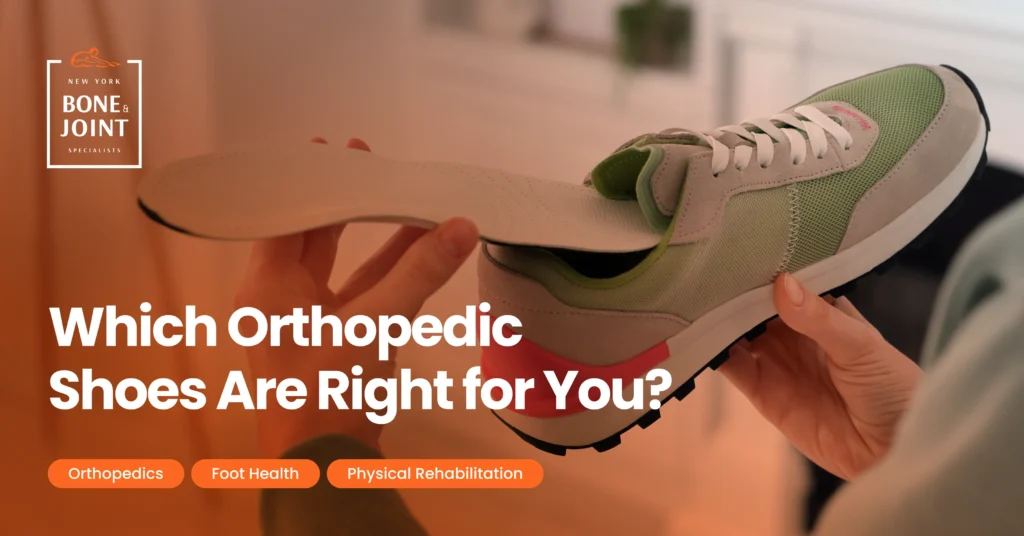Today’s orthopedic shoes are not only better for your feet — they’re also stylish. Here’s how to find your perfect pair.
When you picture orthopedic shoes, you probably imagine clunky, unfashionable footwear. Nowadays, that’s not the case. Today’s versions of orthopedic shoes are made to fight foot pain while also being nice enough to wear on a day out.
As the population ages, more adults will need orthopedic shoes. One estimate pegs the global orthopedic shoe market to rise to $8.9 billion by 2031. Yet choosing the best orthopedic shoes can be a challenge. In this guide, we cover key features to look for in orthopedic shoes to help you shop for the right pair.
Orthopedic shoes vs. regular shoes
Regular shoes are fine if you have no underlying foot pain or condition. Otherwise, walking around on pairs of worn-out, stretched shoes can make your feet feel more achy and uncomfortable. Orthopedic shoes are specially designed for those with painful feet due to various orthopedic ailments, such as arthritis, plantar fasciitis, bunions, and neuropathy. When you wear orthopedic footwear, you’ll feel less discomfort and can move much more freely. That’s because orthopedic footwear helps properly align your posture so you’re putting less stress on your back, knees, and hip joints, all while reducing foot pain.
Orthopedic shoes can be bought off the shelf or custom-made for your foot shape, gait, and specific condition. They also come in a variety of styles, from sneakers and sandals to more formal footwear, so you’re sure to find a pair that’s both fashionable and functional for your lifestyle. Orthopedic shoes can be more expensive than regular shoes, but the investment is well worth it for your foot health.
7 features to look for in orthopedic shoes

Finding the best orthopedic shoes for you depends on looking for features that will counteract your specific foot problem. Also, take into consideration your lifestyle: Are you active and want a pair for exercising? Or do you just want shoes that will get you through your day in comfort?
To get started, here is a list of what to focus on as you shop for orthopedic footwear:
1. Arch support. Heel and foot pain are often associated with low arches or flat feet. Shoes with strong arch support lessen the stress on the bottom of your foot.
2. Wide toe box. Give your toes room to move, especially if you have bunions or hammertoes.
3. Cushioning. If you have arthritis in your feet, every step can be painful. Shoes with solid cushioning act as shock absorbers, thereby reducing pain in your feet, knees, and hip joints.
4. Extra depth and width. Shoes with extra width and depth are perfect for those prone to foot swelling, as they expand as the foot swells. Look for velcro closures that provide a bit more give at the top of the shoe. Plus, if you wear inserts or orthotics, you’ll need that extra roominess.
5. Seamless interiors. Rough edges inside footwear may irritate the feet of people with diabetes, leading to sores. So, turn to shoes with seamless interiors and soft materials to protect your feet from scratches.
6. Hard heels. A strong heel area stabilizes the foot and counteracts excessive pronation (inward roll of the foot) or supination (outward roll of the foot), which can throw off your gait and cause joint pain and foot issues.
7. Non-slip soles. Soles that provide a measure of traction can prevent falls in those with foot pain or balance issues.
When trying on a pair of orthopedic shoes, make sure they feel comfortable right from the start, as there shouldn’t be a need to “break them in.” Consult with a podiatrist or orthopedist for assistance, and take your time to choose wisely — you want shoes that will last a long time.
Understand your feet better
As a leading sports medicine center, the doctors at New York Bone & Joint treat all types of orthopedic issues, including those involving the foot or ankle. If you’re looking to resolve foot pain and improve your quality of life, book a consultation with Dr. Christine Ellie, the best-rated podiatric surgeon in NYC. She’ll diagnose your condition and develop a treatment plan to get you back on your feet.




